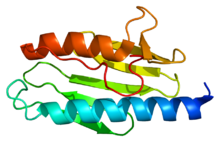| Friedreich's ataxia | |
|---|---|
| Other names | Spinocerebellar ataxia, FRDA, FA |
 | |
| Frataxin | |
| Pronunciation |
|
| Specialty | Neurology, Genetics |
| Symptoms | Muscle weakness, ataxia, fatigue, speech difficulties, scoliosis, heart disease, diabetes |
| Complications | Cardiomyopathy, scoliosis, diabetes |
| Usual onset | Childhood or adolescence |
| Duration | Long-term, progressive |
| Causes | Mutation in FXN gene |
| Risk factors | Family history (autosomal recessive inheritance) |
| Diagnostic method | Clinical evaluation, genetic testing, MRI, electromyography |
| Treatment | Symptom management, physical therapy, |
| Medication | Omaveloxolone |
| Prognosis | Progressive; reduced life expectancy |
| Frequency | 1 in 50,000 (United States) |
| Deaths | Often due to cardiac complications |
Friedreich's ataxia (FRDA) is a rare, inherited, autosomal recessive neurodegenerative disorder that primarily affects the nervous system, causing progressive damage to the spinal cord, peripheral nerves, and cerebellum, leading to impaired muscle coordination (ataxia). The condition typically manifests in childhood or adolescence, with initial symptoms including difficulty walking, loss of balance, and poor coordination. As the disease progresses, it can also impact speech, vision, and hearing. Many individuals with Friedreich's ataxia develop scoliosis, diabetes, and hypertrophic cardiomyopathy, a serious heart condition that is a leading cause of mortality in patients.
Friedreich's ataxia is caused by mutations in the FXN gene, which result in reduced production of frataxin, a protein essential for mitochondrial function, particularly in iron-sulfur cluster biogenesis. The deficiency of frataxin disrupts cellular energy production and leads to oxidative stress, contributing to the neurological and systemic symptoms associated with the disorder.
There is currently no cure for Friedreich's ataxia, but treatment focuses on symptom management and slowing disease progression. In 2023, the U.S. Food and Drug Administration (FDA) approved Omaveloxolone as the first treatment for Friedreich's ataxia. This medication works by reducing oxidative stress and inflammation in neurons, which helps improve motor function in some patients. Ongoing research continues to explore potential therapies aimed at increasing frataxin levels, protecting mitochondria, and addressing the genetic cause of the disease. Although life expectancy may be reduced, particularly due to cardiac complications, advancements in care and treatment have improved outcomes for many individuals with Friedreich's ataxia.